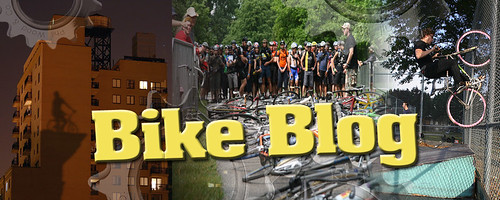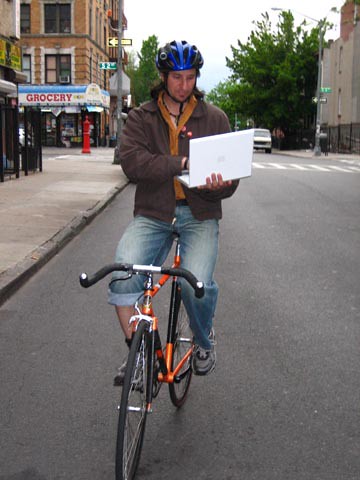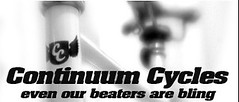Swedish article about NYC Bike Culture
If you read swedish check the original article
[Berge, Lars, “Budbärare”, Svenska Dagbladet, 9 April 2006]
A thing to ponder over when you bring out your bicycle for the upcoming spring: Be happy that you do not live in New York. Biking in New York is associated with danger for one’s life and the people riding on two wheels are subject to confinement en masse. To bike in New York is to take a political stance, and a subculture has emerged around the bicycle.
A bicycle painted in white can be found leaning against a lamppost in the intersection of Houston Street and Avenue A on the southeast of Manhattan. Someone has screwed a sign to the lamppost: “Brandie Bailey, 21 years old. Killed by truck, May 8 2005. Rest in peace.” Burned-out candles can be found on the ground. The flowers clinging to the spokes of the wheels have withered. Almost a week has passed since a funeral march of cyclists stopped by. Some of them held their bikes over their heads in silence. Flowers and candles where set out. After a reverence, the formation biked on till the next scene of accident. 21 persons were overrun and killed in the New York traffic during 2005. The number of wounded are counted in the thousands.
L Train takes us over East River. We get off at Montrose. We are here to meet the photographer Tod Seelie, who has followed Brooklyn’s bike scene for several years. The tall-bike gang Black Label Bike Club NYC arranges a costume party over at a run-downed place called Wreck Room. Peculiar bikes stand leaned in hoards towards the building. Some have a saddle height of two meters.
Observant New Yorkers may have read in the Village Voice about “Mutant Bike Gangs of New York”. But it constitutes an unknown phenomenon for the majority. In the article Black Label is designated, possibly rather speculative, as “anarchists who search for bike parts and thrown-away vegetarian food in the dumpsters. On the contrary, the bar turns out to be packed with art school hipsters. The kind of people that live together in attic apartments and work on “own projects” in film, art or music. And wash their hair very seldom. The gang members wear jeans vests with their emblem on the back. An artist who calls himself Mr Andersonic is performing in an adjacent room. It is very likely that Brandie Bailey had been here if it had not been for that garbage truck. Tod Seelie used to meet here on attic parties and gigs in the area. She worked as a waitress in a vegan restaurant on Manhattan during the day hours, a place where Tod used to eat his lunch. As many other young New Yorkers which had chosen the alternative lifestyle, she used to ride her bike wherever she went.
- She was a very kind soul. It was a big loss for all of us, says Seelie whose blog Suckapants.com is one of the most up-to-date sources for activities circling New York’s bike scene.
New York is one of the Liberal’s strongest holds. The thought that President Bush was moved into power by the military industry and that the war in Iraq is about securing oil findings is not an uncommon opinion here. At the same time, the city is being filled with more and more cars. The nation’s busiest streets are located in the business district of Manhattan. 830 000 cars pass here each day. You don’t cycle here because it is nice or in order to get a breath of fresh air [Swedes mentality towards biking, translator’s comment]. You bike because it is an efficient, but dead dangerous mean to get through the traffic. For many people in the minority which choose to bike, biking is also a political stance. A protest on two wheels against a bolting consumption culture that is regarded as devastating for people and the environment. They gather every last Friday of the month at Union Square in order to bike along the streets of Manhattan en masse. The phenomenon is called Critical Mass and it grew steadily in popularity during the 90s. It culminated during the Republican convention in August 2004 when over 5,000 bikers rolled south along Broadway. A manifestation that got an abrupt end when NYPD suddenly carried out one of the biggest mass arrests in the history of New York.
The flyer to tonight’s costume party reads: “We have seen the future, and it goes to hell!” And yes, people at the Wreck Room do indeed party like there is no tomorrow. Tod Seelie introduces us to Brendt Barbur. If you are to ask questions about urban bike culture, Brendt is the man to ask. He decided to missionize when he left the hospital. He is determined that the bike may be the answer to many of our time’s biggest problems.
- Take obesity, take our dependence on oil, take environmental pollution. I am not saying that the bike is the sole answer to these problems. But it may very well be on of the answers.
Barbur started the Bicycle Film Festival. It grew from having started out as a local interest with stencilled programmes on a smaller New York cinema. Last year, Barbur took his festival to San Francisco, Los Angeles, London and Tokyo. 17,000 tickets were sold in total.
- I wanted to give the movement a voice. I wanted to do something where the bike was the star, says Barbur.
Among the festival line-up, one can for example find Lucas Brunelle’s embedded coverage from breathtaking illegal bike races with New York’s messengers. The movies where he bikes with his camera mounted to his helmet have been downloaded from the Internet by over one million people. And of course, the movie that Barbur refers to as the best about a bike that has ever been produced: A Sunday in Hell, the Danish producer Jörgen Leth’s in-depth study about lactic acid from the cycle tour Paris-Roubaiz from 1976.
- But what has really engaged many festival visitors is the chaos during the Republican’s convention, says Barbur.
Everything is documented in “Still We Ride”, a movie he himself co-produced.
- Earlier, Critical Mass had been about protesting against car traffic, hook up with girls, the safety of biking together or whatever reason one could have. But that time, it was more political. The fact that the Republican’s selected New York for their convention was a viewed as mockery by many of the city’s inhabitants. Bush is not that popular here. Especially among those who have chosen to bike, says Barbur.
More people than ever turned up. The irritated horns from the cars where drowned by their whistles and cheers.
- We suddenly discovered that there were snipers on the surrounding roofs. The helicopters were hovering in the air. After one hour, the riot police struck. It was brutal, there were people who got one of their arms beaten off.
264 cyclists were arrested and their bikes were confiscated as “evidence”. The monthly manifestations have continued, in despite of the police tougher stance. The police withholds that the bikers interrupts the traffic and order, and that the organisers need to apply for a permit to demonstrate. The participating organisations, such as the environmental rights group Times Up, states that Critical Mass is not at all something that should be viewed as an organised protest. It is just a chance for people who like to bikes to meet up.
- We are treated as terrorists. Agents are spying on us. The police send infiltrators to Critical mass actions. They videotape grieving people during the memorial trips. The stop bikers haphazardly and give them high fines just for nonsense. It recalls harassment, says Barbur.
The fact that the authorities have placed the spotlight on the bikers
instead of chasing the city’s reckless drivers has upset many. Especially Brandie Bailey’s case stirred up bad blood. It was not until 23 blocks until a patrol stopped the garbage truck that killed her. The driver was set free and avoided trial. The death of the girl was considered an accident. In despite of, or maybe thanks to, the increasingly harsher climate, the American bike culture is flourishing. To bike has simply become cool. Like the majority of alternative movements, it has its own movies, music and fashion that have been inspired by the city’s foolhardy messengers. Naturally, it also has its own art. We sit in an enormous warehouse under the Williamsburg Bridge the following day. A gigantic, old dog limps around among at least hundred bikes, all different models. Here, Taliah Lempert lives and works. Her husband runs a bike store on Lower East Side, and most of her friends are bike enthusiasts. She competes on exercise level and she often participates in the city’s rolling manifestations.
She has painted the same motive for nine years. In hundreds of different variations. She has depicted bikes for Olympic champions. For local messengers. For all kinds of people that travel through life on two wheels and she has developed a passionate relationship to her vehicle.
- For me, the bike is liberation. It makes it possible for me to use all my energy to ride fast. In addition, it is beautiful, says Lempert while she carefully paints the metallic reflector on the spokes in green.
- With the bicycle, you can stop and talk to people. It is not like the car that makes people isolated and frustrated. It is really a shame that our whole economy, our culture, is built around it. A statement that Brandie Bailey certainly would put her name to. On the Internet, her memory lives on. Her blogspot on Myspace.com is still active. Still, messages are posted from grieving friends. On the 16th of March, Colette wrote: “I woke up this night, convinced that you were still here among us.” But all that is left of here is a ghost bike. Shiningly white among exhaust fume-grey concrete.











1 Comments:
Yo Mike, check this out:
http://www.alleycat.hu/aggregator/sources/32
They got mine too. Weird...
Post a Comment
<< Home